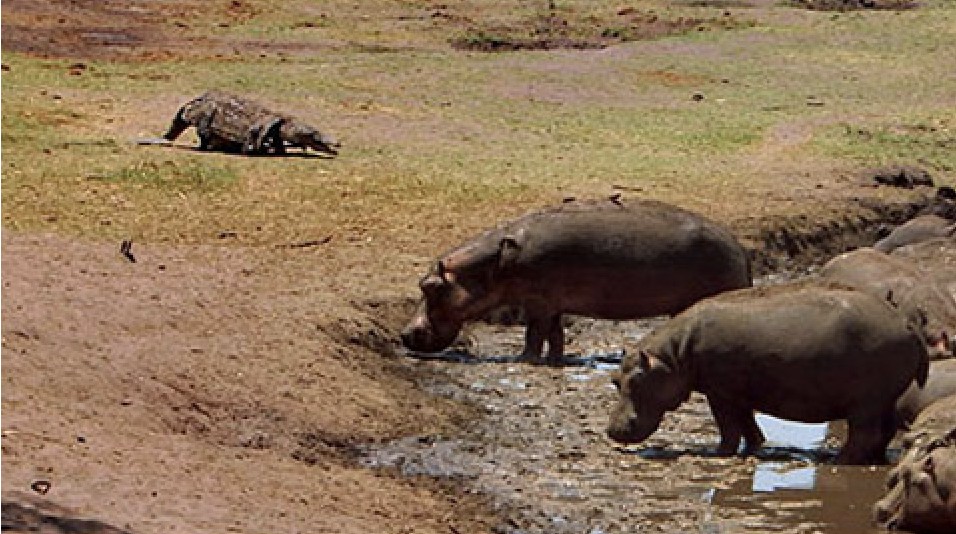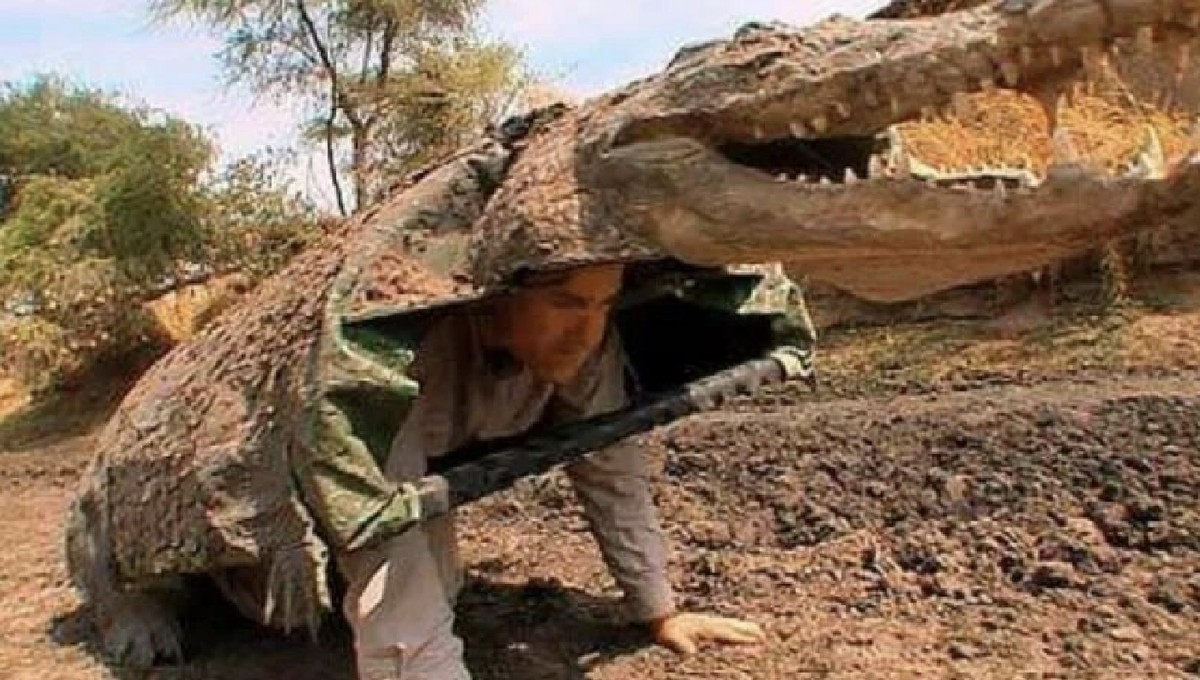A Scientist Wore a Crocodile Suit and Crawled Toward Real Predators — This Is What Happened
Most people fear crocodiles. An American named Brady Barr dedicated his life to them. And in 2007 he took a step his colleagues called suicide: he climbed into a metal suit disguised as a crocodile and headed straight into the lair of Nile predators. The story began almost by accident. Barr came to a school to tell the children about his work. He was already a renowned herpetologist—the scientist who studies reptiles—with more than a hundred documentary films for National Geographic and expeditions to eighty countries behind him. His main pride was his work with every crocodile species on Earth. There are twenty‑three, and Barr caught each of them at least once. No one had done that before him. After the lecture, a schoolboy raised his hand: "Why don't you dress up as a crocodile and get closer to them?" Adults laughed. Barr considered it. The idea seemed crazy, but there was a kernel of sense. Nile crocodiles in Africa really cannot be approached. They notice people from afar and immediately retreat to the water. And scientists urgently needed data about these animals—the population was shrinking and no one understood why. To track crocodile movements and understand their conditions of life, sensors needed to be placed on them. Ordinary methods did not work—these animals are too cautious. The only option was to pretend to be one of them. Barr turned to engineers at National Geographic. They initially refused—too dangerous. The Nile crocodile grows up to six meters long and weighs nearly a ton. Their jaws close with a force of about two tons per square centimeter. For comparison, the bite of a German shepherd is ten times weaker. But the scientist insisted. In the end the team agreed to try.

In This Article:
- From a Renowned Herpetologist to a Crocodile Imposter
- The Making of the Crocodile Suit
- January 2007 in Tanzania A Foray Into the Nile Crocodile’s Lair
- First Contact: The Moment of Close Proximity
- The Moment of Acceptance and Sensor Placement
- Data Collection and Safe Retreat
- Legacy and Reflection A Lifetime After the Feat
From a Renowned Herpetologist to a Crocodile Imposter
Barr’s career as a fearless field scientist had already included more than a hundred National Geographic documentaries and expeditions to dozens of countries. The idea of becoming a crocodile himself grew from the question asked in the school, and the need to learn where Nile crocodiles roam and how they behave in their habitat. The aim was to gather crucial data by tagging and tracking with sensors, something impossible to accomplish with conventional methods while the animals remained wary. Barr and his team initially sought help from engineers at National Geographic. They were skeptical, but after much discussion the team agreed to attempt the plan.

The Making of the Crocodile Suit
The project stretched over twelve months. Specialists made a plaster cast of the head of a real crocodile and cast a dummy from it. It turned out light—made of expanded plastic foam. They attached a protective frame to the body from steel rods. On top they wrapped Kevlar fabric—used for bulletproof vests. And over all they pulled a rubber sleeve with a scale pattern. The finished construct weighed thirty-six kilograms. The person inside could only crawl on all fours. Visibility was almost zero—about three meters ahead and nothing to the sides or behind. But the biggest problem was not this. Crocodiles have an excellent sense of smell. They detect scents from kilometres away. A human scent would set them on alert immediately. Therefore the entire suit was soaked with a mixture of crocodile dung, hippopotamus dung, and river silt. It smelled terrible, but convincing.

January 2007 in Tanzania A Foray Into the Nile Crocodile’s Lair
January 2007. Tanzania, on the banks of a great river. The heat rose to around 50°C. Barr was forty‑four years old—not the best age for extreme experiments. He climbed into his suit. It immediately grew hot and confining. Within a minute his shirt was soaked through. Inside it felt like a sauna. The first obstacle on the way was a herd of hippos. A whole group lay between the scientist and his target. Many people think hippos are gentle, but they are among Africa’s most dangerous animals. They kill more people each year than crocodiles and lions combined. They weigh about two tons and can outrun a human. Their tusks half a meter long can pierce through. Barr began to crawl. Slowly, trying not to make noise. The metal frame creaked. Stones pressed into his knees even through the fabric. His hands slipped. Hippos were about thirty meters away. Twenty. Ten. One hippo turned its head and looked at the strange creature. Barr froze. A few seconds of silence. The hippo turned away—uninterested. The scientist exhaled and continued crawling.

First Contact: The Moment of Close Proximity
Now the Nile crocodiles lay ahead in a tight group—about twenty adults basking on the sand. Barr saw them from a distance: huge bodies, eyes closed, mouths open, lying in a crowd almost touching one another. There were about sixty meters of open shoreline to them. The filming crew stood far behind with cameras and radios. The scientist moved forward, stopping every five meters to catch his breath. The heat was unbearable. The metal frame felt like an oven. Sweat blinded his eyes, but he could not wipe it away—his hands were busy. Thirty meters to the crocodiles. Twenty. Not a single head rose. Fifteen meters. One crocodile rose, walked toward the water, and passed right by the crawling “brother.” It went by within a couple of meters and didn’t even glance. Ten meters. Barr’s head spun. Whether from heat or tension is unclear. Five meters. A crocodile right in front of him suddenly opened its eyes and stared at him. The scientist froze in place. Seconds stretched into what felt like hours. The crocodile slowly turned its head toward him. They were almost nose to nose—the crocodile’s snout nearly touched the dummy. Barr held his breath and thought, "If it attacks now, the suit won’t save me."

The Moment of Acceptance and Sensor Placement
The crocodile finally yawns, its huge pink mouth with crooked yellow teeth visible, then lowers its head back to the sand and closes its eyes. It’s over for the moment. Barr reaches the group. He is now among them in effect. A giant crocodile to his left—about five meters long— and another smaller one to his right. He carefully applies the first sensor to the nearest crocodile, pressing the special glue to hold the device for months. The moment of balance turns to mistake when he jerks his hand too quickly. The crocodile immediately turns, and they are muzzle to muzzle with the artificial head barely inches from the scientist’s face. The inside of the mouth is pink and wet; the teeth are irregular and some are broken. Barr does not move. Not at all. "Don’t move," he reminds himself. "Not a single movement." The seconds feel like minutes as the animal eyes the dummy, noses it, then slowly turns away and settles down. Behind him, another huge crocodile has flopped down close to the suit, and Barr realizes he has been accepted as one of their own.

Data Collection and Safe Retreat
Barr begins to relax only to realize that there is another crocodile behind him as well—he cannot turn around, but he can feel the warmth of another body through the rubber and metal. He stays motionless for about ten minutes, then continues to attach two more sensors to different crocodiles. He moves with extreme caution; the predators nap, yawning and brushing their tails. It resembles a herd of cows on a meadow. Finally the task is complete. Three sensors are in place. It’s time to leave. But leaping to his feet and sprinting away would invite an attack. He must crawl back just as slowly. Barr inches backward for what feels like forever. When there are about fifteen meters left to the filming group, he allows himself to accelerate. He crawls the final stretch, collapses on his back, and lies there for five minutes, unable to move. When the frame is removed, a pool of sweat spreads beneath him. “Never again,” he tells the operators. “That was the last time.” But there is happiness in his eyes. The experiment worked. The data arrived. And most importantly it proved what many did not believe: you can approach crocodiles if you use enough wit and courage.

Legacy and Reflection A Lifetime After the Feat
Today Brady Barr is sixty-one years old. He still works, but differently. He runs educational programs, writes books, and gives lectures. Together with his wife Mei Len he opened a center where they teach children and adults to treat nature with care. "Crocodiles are unique creatures," he says. "They have hardly changed for millions of years. They survived the dinosaurs, ice ages, catastrophes. This means that nature found in them an ideal solution. They are perfect in their niche." Barr believes the main problem in human‑crocodile relations is misunderstanding. People see them as monsters from horror films. In reality they are simply animals that live by their own laws. They are not evil and not cruel. They are simply as evolution made them. "When I lay among them in that suit," the scientist recalls, "I felt not fear but interest. I was curious how they would behave. And when one lay next to me, I understood—we can coexist. We simply need to respect their territory and understand their habits." The Bar’s experiment became famous. It is taught in zoology textbooks. It is shown to students as an example of an unconventional approach to research. But the main thing is not that. The main thing is that it changed crocodiles’ perception for millions of people. After that film, many started to treat these predators differently. A curiosity arose, a desire to learn more, to understand their role in nature. Barr himself never wore that suit again. He says that one time is enough. The risk is too great, and his age is no longer what it was. But those ten minutes among Nile crocodiles became the pinnacle of his thirty-year career.

